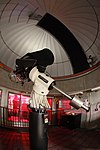O'Shaughnessy Stadium
1948 establishments in MinnesotaMidwestern United States sports venue stubsMinnesota building and structure stubsMinnesota sport stubsMulti-purpose stadiums in the United States ... and 3 more
Sports venues completed in 1948Sports venues in MinnesotaUniversity of St. Thomas (Minnesota)

O'Shaughnessy Stadium is a multi-purpose stadium in St. Paul, Minnesota. It is the home of the St. Thomas Tommies football and track and field teams, in addition to various intramural sports. The stadium opened in 1948 and is named for Ignatius O'Shaughnessy, an alumnus of St. Thomas and a donor to the school.The stadium was most recently renovated in 2017 with the addition of a new field turf surface and track surface. The seating capacity of the stadium is 5,025, though its record attendance was 12,483, achieved on September 14, 2014 during a football game against Saint John's.
Excerpt from the Wikipedia article O'Shaughnessy Stadium (License: CC BY-SA 3.0, Authors, Images).O'Shaughnessy Stadium
Cretin Avenue South, Saint Paul Union Park
Geographical coordinates (GPS) Address Nearby Places Show on map
Geographical coordinates (GPS)
| Latitude | Longitude |
|---|---|
| N 44.943556 ° | E -93.191631 ° |
Address
Palmer Field
Cretin Avenue South
55104 Saint Paul, Union Park
Minnesota, United States
Open on Google Maps







